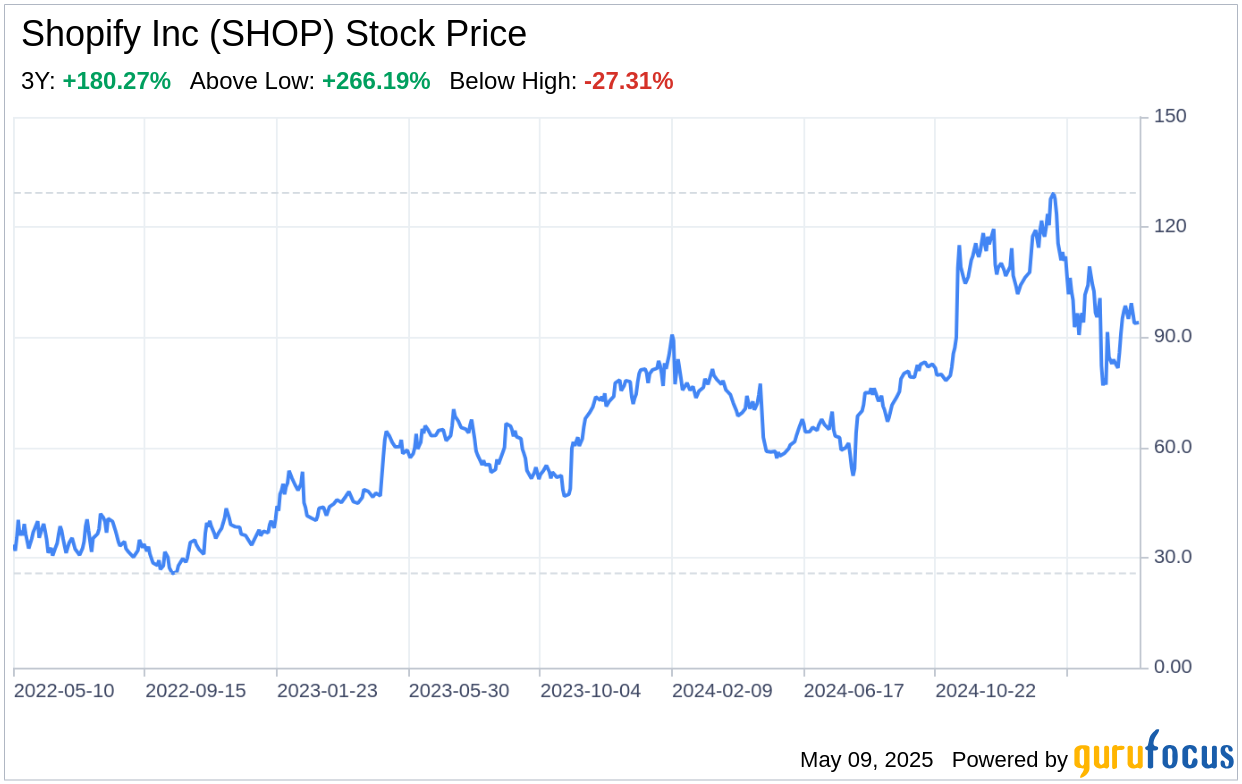Shopify Inc (SHOP, Financial), a leading global commerce company, recently filed its 10-Q report on May 8, 2025, revealing insightful financial performance and strategic directions. The company, known for its e-commerce platform catering to small and medium-sized businesses, reported a 27% increase in total revenue for the quarter ended March 31, 2025, compared to the same period in the previous year. Despite this growth, Shopify experienced a net loss of $682 million, a significant increase from the $273 million loss reported in the prior year. This SWOT analysis delves into Shopify's strengths, weaknesses, opportunities, and threats, providing a comprehensive view of the company's current position and future prospects.

Strengths
Revenue Growth and Diversified Solutions: Shopify Inc (SHOP, Financial) has demonstrated a strong revenue trajectory, with its total revenue reaching $2.36 billion for the quarter, marking a 27% increase year-over-year. The company's subscription solutions, which include a range of plans and Shopify Plus for larger businesses, grew by 21%, generating $620 million. This growth reflects Shopify's ability to attract and retain a diverse merchant base, offering solutions that scale with their businesses. The flexibility of Shopify's pricing plans and the addition of features like Shopify Audiences and B2B capabilities contribute to its appeal among a wide range of merchants, from small startups to established brands like SKIMS and Supreme.
Merchant Solutions Expansion: The merchant solutions segment, which includes Shopify Payments and Shopify Capital, has become a significant revenue driver, accounting for 74% of total revenues. This segment saw a 29% increase, reaching $1.74 billion for the quarter. The growth in merchant solutions is closely tied to the 31% increase in gross merchandise volume (GMV) facilitated through Shopify Payments, indicating a higher adoption rate among merchants. The expansion of Shopify Capital, which provides financing options to eligible merchants, further underscores the company's commitment to supporting merchant success and growth.
Strategic Acquisitions and AI Investments: Shopify's strategic acquisitions, such as the purchase of Vantage for $59 million, showcase its commitment to enhancing its platform's capabilities. The acquisition aims to accelerate the development of AI-powered search across Shopify's offerings, which is expected to improve the shopping experience for consumers and drive sales for merchants. Additionally, the company's ongoing investments in data analytics, machine learning, and AI signal its focus on leveraging emerging technologies to maintain a competitive edge and foster innovation.
Weaknesses
Net Loss and Investment Risks: Despite revenue growth, Shopify Inc (SHOP, Financial) reported a net loss of $682 million for the quarter, significantly higher than the $273 million loss in the previous year. This loss was primarily driven by a $1,021 million net unrealized loss on equity and other investments, reflecting the volatility and risks associated with the company's investment portfolio. The net loss underscores the need for Shopify to manage its investments more effectively and mitigate the impact of market fluctuations on its financial performance.
Operational Costs and Efficiency: The company's cost of revenues, particularly in the merchant solutions segment, increased by 29%, outpacing revenue growth in the same segment. This indicates a potential inefficiency in managing payment processing fees and other associated costs. As a percentage of revenues, the cost of merchant solutions also increased, suggesting that while Shopify Payments is contributing to revenue growth, it may also be exerting pressure on margins. Addressing these operational inefficiencies could be crucial for improving Shopify's profitability.
Dependence on Merchant Success: Shopify's business model is heavily reliant on the success of its merchants. While this creates a strong alignment of interests, it also exposes the company to risks if merchants face economic downturns or increased competition. The company's ability to retain and grow its merchant base is critical, and any factors that negatively impact merchant businesses could have a significant effect on Shopify's financial health.
Opportunities
Market Expansion and International Growth: Shopify Inc (SHOP, Financial) has significant opportunities to expand its international presence and tap into emerging markets. The company's intention to further tailor its sales strategies to attract larger volume brands and its investments in localizing features for specific geographies position it well for global expansion. By meeting the needs of merchants in different regions and adapting to local market conditions, Shopify can broaden its reach and diversify its revenue streams.
Product and Service Innovation: The company's focus on developing new solutions and extending its platform's functionality presents opportunities for growth and differentiation. Shopify's investments in AI and machine learning can lead to innovative products that enhance the merchant and consumer experience, such as personalized shopping recommendations and improved search capabilities. Additionally, the expansion of Shopify Capital and the exploration of new pricing models offer avenues for additional revenue and merchant support.
Strategic Partnerships and Ecosystem Strengthening: Shopify's robust third-party ecosystem and partner program are key drivers of its success. By forming strategic partnerships and enhancing integration with other platforms and services, Shopify can offer a more comprehensive suite of tools for merchants. This not only improves the platform's value proposition but also creates potential for new revenue-sharing models and collaborative growth initiatives.
Threats
Competitive Landscape and Market Saturation: The e-commerce platform market is highly competitive, with several established players
This article, generated by GuruFocus, is designed to provide general insights and is not tailored financial advice. Our commentary is rooted in historical data and analyst projections, utilizing an impartial methodology, and is not intended to serve as specific investment guidance. It does not formulate a recommendation to purchase or divest any stock and does not consider individual investment objectives or financial circumstances. Our objective is to deliver long-term, fundamental data-driven analysis. Be aware that our analysis might not incorporate the most recent, price-sensitive company announcements or qualitative information. GuruFocus holds no position in the stocks mentioned herein.
